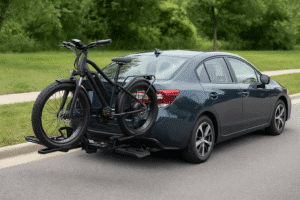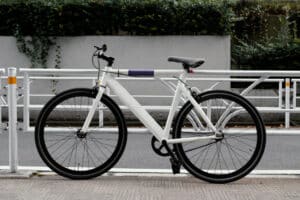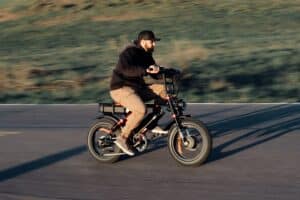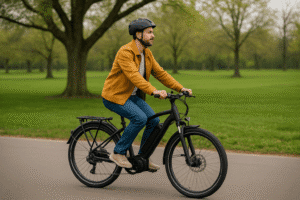Fat tire bikes and mountain bikes might look similar at first glance, but they’re made for very different adventures.
Fat tire bikes are built to handle soft ground like snow and sand, while mountain bikes are designed for rough, rocky trails where speed and control matter most.
Choosing between them depends on where you ride, how you ride, and the kind of terrain you love tackling.
Key Summary:
- Fat tire bikes are built for snow, sand, and soft trails with extra-wide tires for grip and stability.
- Mountain bikes are lighter, faster, and ideal for rocky or technical terrain.
- Fat bikes offer more comfort and traction but are slower on pavement.
- Mountain bikes provide better agility, efficiency, and control on firm trails.
What is a Fat Tire Electric Bike
A fat tire electric bike is a type of e-bike with extra-wide tires, usually between 3.7 and 5 inches, that run at low pressure to provide better traction and balance on soft or uneven surfaces. The electric motor helps you power through tough conditions like snow, sand, or mud with less effort.
These bikes are known for their stability and comfort. The wide tires absorb bumps naturally, which makes them great for riders who value a smooth, cushioned ride.
While they can feel slower on paved roads, their ability to “float” over soft terrain makes them a favorite for off-road explorers and year-round commuters.
Because of their all-terrain performance, fat tire e-bikes are often used for winter rides, beach trails, and even light mountain paths.
Riders who want versatility and comfort over speed often prefer them.
Pros of Fat Tire Electric Bikes
Fat tire e-bikes are perfect for riders who want stability and traction in tough conditions.
- Excellent grip on snow, sand, and mud
- Extremely stable and beginner-friendly
- Comfortable ride with natural shock absorption
- Suitable for year-round riding and all weather types
- Great for exploring areas where regular bikes would sink or slip
Cons of Fat Tire Electric Bikes
While durable and fun, they’re not the best choice for everyone.
- Heavier than standard bikes, making them harder to lift or carry
- Slower on paved or hard surfaces due to rolling resistance
- More effort is required when pedaling without motor assist
- Tires and rims can be more expensive to replace
- Less agile for quick turns or steep climbs
What is a Mountain Bike
A mountain bike is built for technical trails, rocky climbs, and steep descents. It has narrower tires (usually 1.8 to 2.6 inches wide) and advanced suspension systems to handle bumps and uneven terrain.
These bikes are known for agility, speed, and precise control on challenging surfaces.
Unlike fat tire bikes, mountain bikes are lighter and faster, which makes them ideal for trail riding and hill climbs. They often include multiple gears, hydraulic brakes, and strong frames designed to withstand rough impact.
Mountain bikes come in several types: hardtail, full suspension, and cross-country, each offering different performance benefits.
Whether you’re navigating forest trails or rocky mountain paths, a mountain bike delivers power, control, and efficiency where precision counts.
Pros of Mountain Bikes
Mountain bikes excel at speed, control, and trail versatility.
- Lightweight and easier to maneuver
- Excellent suspension for rocky or bumpy terrain
- Faster and more efficient on hard trails
- Strong braking and precise steering for better control
- Available in many styles for different trail conditions
Cons of Mountain Bikes
They’re not perfect for every environment or rider.
- Struggle on soft terrain like sand or snow
- Less comfortable on rough trails without suspension tuning
- More complex components mean higher maintenance costs
- Narrower tires offer less traction on loose surfaces
- Can feel less stable for new or casual riders
Fat Tire Bike vs Mountain Bike: Key Differences
Fat tire bikes use wide, low-pressure tires for better traction on soft surfaces like snow and sand, while mountain bikes are built for speed, agility, and control on rocky or technical trails. Fat bikes feel more stable and forgiving, but mountain bikes are faster, lighter, and more responsive.
Here’s a quick breakdown of how they compare side by side:
| Feature | Fat Tire Bike | Mountain Bike |
|---|---|---|
| Tire Width | 3.7″–5″, low-pressure tires for grip and flotation | 1.8″–2.6″, higher-pressure tires for speed and control |
| Best Terrain | Soft surfaces like sand, snow, and mud | Rocky, steep, and technical trails |
| Ride Feel | Stable, cushioned, and forgiving | Agile, fast, and highly responsive |
| Weight | Heavier due to wide tires and larger frames | Lighter and easier to handle |
| Suspension | Often rigid; tires absorb most shocks | Advanced suspension systems for rough trails |
| Speed | Slower due to high rolling resistance | Faster and more efficient on firm terrain |
| Comfort | Very comfortable, absorbs bumps naturally | Comfort depends on suspension setup |
Tires and Traction
Fat tire bikes use massive, low-pressure tires that grip everything: sand, snow, or slush.
They’re designed to spread weight over a wider surface, which prevents sinking and slipping. This makes them feel almost unstoppable on loose ground.
Mountain bikes, on the other hand, have narrower tires that roll faster and cut through hard dirt, gravel, and rocky terrain.
Their tread patterns are sharper and designed for precision control, especially on climbs and descents.
In short, fat tires focus on grip and stability, while mountain tires focus on speed and handling.
Speed and Efficiency
If you love covering long distances or tackling hilly trails, mountain bikes are far more efficient. The narrower tires and lightweight build help you go faster with less effort.
Fat tire bikes trade off that efficiency for stability. Their wider tires create more drag, meaning you’ll burn more energy on pavement or compact dirt. On soft surfaces, though, they maintain steady traction where a mountain bike would slip or stall.
Ride Comfort and Stability
A fat tire bike feels like riding on air. The thick tires act as natural shock absorbers, softening bumps and vibrations. Even without suspension, the ride stays smooth and comfortable.
Mountain bikes handle shock differently. Their suspension systems, either front-only (hardtail) or both front and rear (full-suspension), absorb the impact of rough terrain, giving more control on steep or rocky trails.
So, fat bikes offer passive comfort, while mountain bikes deliver active suspension control.
Handling and Agility
When it comes to maneuvering, mountain bikes win hands down. Their lighter frames and responsive geometry let you weave through tight turns, hop over roots, and adjust speed quickly.
Fat tire bikes feel steadier but less agile. The heavy tires can make steering slower, especially on narrow trails. But that same weight gives them unmatched balance on tricky or slippery paths.
If agility and quick reactions matter to you, a regular MTB is the better fit. If you value steadiness and control, go with a fat tire bike.
Weight and Maintenance
Fat tire bikes are heavier, often due to larger rims, thicker tubes, and wider frames. While this makes them sturdy, it also means more work when carrying or storing the bike.
MTBs are typically lighter, though their advanced suspension systems and gear setups require more frequent maintenance.
Fat bikes, in contrast, have simpler components but can need more effort when replacing tires or rims due to their size.
Terrain and Weather Adaptability
If you plan to ride year-round, especially through snow or beach sand, a fat tire bike is unbeatable. It adapts well to weather changes and can handle terrain most bikes can’t touch.
Mountain bikes perform best in dry, rugged conditions: forests, hills, or singletrack trails. While they can handle light mud or gravel, deep sand and snow are not their strong suits.
So fat tire bikes dominate soft terrain, while mountain bikes shine on hard, technical trails.
Which Bike Should You Choose?
The best bike for you depends on where you ride most often and what kind of experience you want. Fat tire bikes are all about comfort and stability on soft ground, while mountain bikes deliver speed and control on challenging trails.
Choose a Fat Tire Bike If You:
- You often ride on snow, sand, or muddy trails.
- Comfort and stability matter more than speed.
- You like year-round riding in all weather conditions.
- You prefer an easy, forgiving ride that doesn’t require technical skill.
- You want an electric option that handles uneven terrain smoothly.
Choose a Mountain Bike If You:
- You love trail riding, climbs, and steep descents.
- Speed, agility, and precise control are your priorities.
- You ride mostly on hard-packed dirt, gravel, or rocky paths.
- You don’t mind regular maintenance for high performance.
- You enjoy the challenge of technical, adrenaline-filled rides.
Read more: Best electric mountain bike under $3000
Can You Use Them Interchangeably?
You can use a fat tire bike on mountain trails or a mountain bike on soft terrain, but each will feel out of its element. Fat bikes handle sand and snow far better, while mountain bikes excel on firm, uneven ground.
A fat tire bike can manage hard trails, but it’ll feel slower and heavier, especially during long climbs. On the flip side, a mountain bike can struggle in deep snow or sand, where its narrow tires sink and lose traction.
If your riding locations vary, some riders keep both, using a fat tire bike for winter and beach rides, and a mountain bike for trails and summer adventures. Each shines in its own environment, so think about where you’ll spend most of your time before deciding.
Read more: Tips for choosing an electric bike for every type of rider
Final Words
Both fat tire bikes and mountain bikes offer incredible riding experiences, just for different types of terrain and riders.
Fat tire bikes bring unbeatable traction and comfort for soft, unpredictable surfaces. Mountain bikes deliver agility, speed, and control for technical, rocky trails.
If you’re all about exploring new paths year-round, go for a fat tire bike. But if your thrill comes from conquering trails with precision and speed, a mountain bike is your best partner.
Either way, you’ll end up with a ride that takes you places and makes every pedal worth it.
FAQs
Which bike is better for snow or sand?
Fat tire bikes perform better on snow and sand because their wide, low-pressure tires spread the rider’s weight and prevent sinking. Mountain bikes can handle these surfaces but lose traction quickly.
Are fat tire bikes slower than mountain bikes?
Yes. Fat tire bikes are slower on pavement and hard-packed trails due to rolling resistance. Mountain bikes are lighter and more efficient, making them faster on firm terrain.
Do fat tire bikes need suspension?
Not necessarily. The wide tires naturally absorb shocks and vibrations, providing a cushioned ride even without suspension. However, some models include front suspension for added comfort.
Can you ride a mountain bike in winter?
You can ride a mountain bike in winter if you use studded or winter-specific tires. However, fat tire bikes are safer and more stable on icy or snowy surfaces.
Which one is easier to maintain?
Mountain bikes usually need more maintenance due to their suspension systems and complex gears. Fat tire bikes are simpler mechanically but require attention to tire pressure and rim care.
Michael Josh is a hands-on e-bike tester and reviewer at BoltBikers, known for putting every model through real-world rides before sharing his thoughts. With a sharp eye for performance, comfort, and build quality, he helps the team choose which bikes are worth featuring. Backed by years of experience in tech and gear reviews, Michael brings trusted, honest insights to help readers find the right e-bike for their needs.








